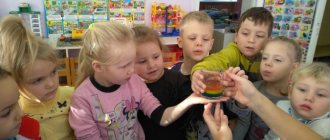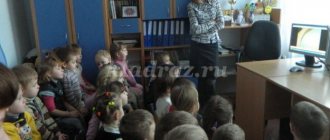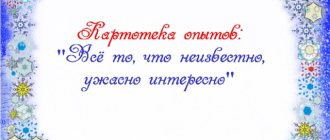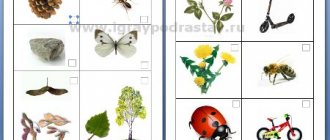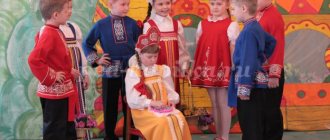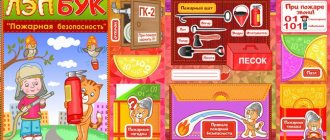On the topic: methodological developments, presentations and notes
Cards-schemes for conducting experiments and experiments for children of senior preschool age (card index).
There is a wide variety of experimental games for children - preschoolers of different age categories. Unusual, very entertaining games will help children become familiar with nature and the world around them.
Children love to experiment. Experimental activities develop children’s observation skills, their skills to compare, analyze, generalize, establish cause-and-effect relationships, etc.
I present to your attention cards - diagrams of experiments and experiments. There are a huge number of different illustrations on the Internet, but do-it-yourself cards-schemes on a computer.
Detailed experimental schemes are presented here.
Source
Experimental activities in kindergarten. Junior group
Cards-schemes for conducting experiments and experiments for children of primary preschool age
The purpose of research activities in the children's laboratory is to promote the development of children's cognitive activity, curiosity, desire for independent knowledge and reflection. The objectives of the experimental activities of children of primary preschool age are formulated in Table 1. Table 1. Objectives Junior preschool age 1. Expanding children's ideas about the world around them through familiarization with elementary knowledge from various fields of science • Development of children's understanding of the chemical properties of substances • Development of elementary knowledge in children ideas about the basic physical properties and phenomena • Development of ideas about the dissolution properties of various substances; the interaction of various substances when combined (reaction) and their influence on the properties of other objects magnetism, reflection of light, sound, heat, freezing and thawing of water, sand, clay, air, stone 2. Development in children of the ability to use devices that help in playing games - experiments magnifying glass 3. Development of mental abilities in children: * development of mental abilities: analysis, classification, comparison, generalization * formation of ways of cognition through sensory analysis 4. Social and personal development of each child: development of commutability, independence, observation, basic self-control and self-regulation of their actions Plan of work in a children's laboratory with children of primary preschool age (Table 2) Table 1. Topics of games - experimentation Month first week second week third week fourth week October Smell, taste, touch, listen Why does everything sound? Clear water Water takes shape November What objects can float? Making soap bubbles Foam pillow Air everywhere December Air works Every pebble has its own house Is it possible to change the shape of stone and clay Light everywhere January Light and shadow Frozen water Melting ice Multi-colored balls February Mysterious pictures We will see everything, we will know everything Sand country Where is the water? March Water mill Ringing water Guessing game Catch the fish, both small and large April Tricks with magnets Sunbeams What dissolves in water? What is reflected in the mirror? May Magic sieve Colored sand Games with sand Fountains Games - experimentation for children of primary preschool age Smell, taste, touch, listen Task: To consolidate children's understanding of the senses and their purpose. Develop the ability to recognize different sounds, determine the smell, shape and structure of the surface, and determine the taste. Cultivate cognitive interest in a person. Materials: bell, hammer, 2 stones, rattle, whistle, talking doll, Kinder surprise cases with holes, garlic, orange slice, foam rubber with perfume, lemon, sugar. Description of the game - experiment: Materials are laid out on the table, children are given the opportunity to study the objects on their own. During this acquaintance, the teacher talks with the children, asking questions: 1. What do these objects sound like? 2. How did you hear these sounds? 3. Do these items smell? Tasks: 1. “Guess what sounds” 2. “Guess by smell” 3. “Guess by taste” 4. “Guess by touch” Conclusion: What would happen if we didn’t have a nose, ears, fingers and tongue ? Why does everything sound? Task: to lead children to understand the causes of sound: vibrations of an object. Materials: Tambourine, glass beaker, newspaper, balalaika or guitar, metallophone, wooden ruler. Description of the game - experiment: The teacher invites the children to close their eyes, and he makes sounds using objects known to them. Children guess what it sounds like. Children are asked to imitate in their voice: what does a mosquito call? (Z-z-z.) How does a fly buzz? (Z-z-z.) Then each child is invited to touch the string of the instrument, listen to its sound and then touch the string with his palm to stop the sound. What happened? Why did the sound stop? The sound continues as long as the string vibrates. When she stops, the sound also disappears. Does a wooden ruler have a voice? Children are asked to make a sound using a ruler. We press one end of the ruler to the table, and clap the free end with our palm. What happens to the ruler? (trembles, hesitates.) How to stop the sound? (Stop the vibration of the ruler with your hand.) Extract the sound from the glass glass using a stick, stop. When does sound arise? The sound occurs when air moves back and forth very quickly. This is called oscillation. Why does everything sound? What other objects can you name that will sound? Transparent water Task: to identify the properties of water (transparent, odorless, pours, has weight). Materials: two opaque jars (one filled with water), a glass jar with a wide neck, spoons, small ladles, a bowl of water, a tray, object pictures. Description of the game - experiment: On the table, two opaque jars are closed with lids, one of them is filled with water. Children are asked to guess what is in these jars without opening them. Are they the same weight? Which one is easier? Which one is heavier? Why is it heavier? We open the jars: one is empty - therefore light, the other is filled with water. How did you guess that it was water? What color is it? What does the water smell like? An adult invites the children to fill a glass jar with water. To do this, they are offered a variety of containers to choose from. What is more convenient to pour? How to prevent water from spilling on the table? What are we doing? (Pour, pour water.) What does water do? (It pours.) What sound do we hear? Water takes shape Task: to reveal that water takes the shape of the vessel in which it is poured. Materials: funnels, a narrow tall glass, a round vessel, a wide bowl, a rubber glove, ladles of the same size, an inflatable ball, a plastic bag, a basin of water, trays. Description of the game - experiment: In front of the children is a bowl of water and various vessels. Little Chick Curiosity tells how he was walking, swimming in puddles, and he had a question: “Can water have some kind of shape?” How can I check this? What shape are these vessels? Let's fill them with water. What is more convenient to pour water into a narrow vessel? (Use a ladle through a funnel.) Children pour two ladles of water into all vessels and determine whether the amount of water in different vessels is the same. Consider the shape of water in different vessels. It turns out that water takes the shape of the vessel into which it is poured. What objects can float? Objective: to give children an idea of the buoyancy of objects, that buoyancy does not depend on the size of the object, but on its heaviness. Materials: large basin with water, plastic, wooden, rubber balls, cones, planks, large and small pebbles, nuts, screws, nets according to the number of children, trays. Description of the game - experiment: All objects are laid out in front of the children. The teacher suggests finding out if all objects can float? Children independently lower objects into the water and observe. What floats? Do all objects float equally on water? Are they the same size? Why do some objects float while others sink? Water puts pressure on an object, pushing it from bottom to top (trying to hold it). If the object is light, the water keeps it on the surface and the object does not sink. If an object is heavy, it puts pressure on the water, and it cannot hold it - the object sinks. (On the flannelgraph it is noted what floats and what sinks.) “Magic Pyramid” 1. Assemble the pyramid from the large ring to the small one. We conclude: it’s worth it. 2. We assemble the pyramid, on the contrary, from small ring to large one. Will it stand? Why? Making soap bubbles? Objective: to introduce children to the method of making soap bubbles, to the properties of liquid soap: it can stretch and form a film. Materials: liquid soap, pieces of soap, a special loop for soap bubbles, cups, water, spoons, trays. Description of the game - experiment: Guys, kitten Vaska came to visit us. He loves to blow soap bubbles. Let's show Vasya what other bubble loops there are. (The teacher demonstrates the types of loops and invites the children to blow into them). - Today we will learn how soap bubbles are made and we will try to make them together. Soap bubbles mean they are made from soap. Take a piece of soap and add water, mix. (The guys and the teacher do it). — We lower the loop into the resulting liquid and blow into the loop. (Children do). — Did we get soap bubbles? (No) . - Now take another glass and mix liquid soap with water. 1 spoon of water and 3 spoons of liquid soap. We lower the loop into the solution and blow. (Children do). You see, now we have succeeded. Bubbles are obtained only from liquid soap. The liquid soap stretches into a thin film, it remains on the loop, we blow out the air. The film envelops it and a bubble is formed. - Let's play with you. “Who can blow more soap bubbles? ", "What shape is the bubble? ", "Which bubble flies further, higher? "(Children blow bubbles and tell what they look like, what color) Foam pillow Task: to develop in children the idea of buoyancy of objects in soap foam (buoyancy depends not on the size of the object, but on its heaviness). Materials: on a tray there is a bowl of water, whisks, a jar of liquid soap, pipettes, a sponge, a bucket, wooden sticks, various items for testing buoyancy. Description of the game - experiment: Misha the bear says that he learned to make not only soap bubbles, but also soap foam. And today he wants to find out whether all objects sink in soap suds? How to make soap foam? Children use a pipette to collect liquid soap and release it into a bowl of water. Then try to beat the mixture with chopsticks and a whisk. What is more convenient for whipping foam? What kind of foam did you get? They try to dip various objects into the foam. What floats? What's sinking? Do all objects float equally on water? Are all objects that float the same size? What determines the buoyancy of objects? (The results of the experiments are recorded on a flannelgraph.) “Does air have weight? » 1. Making homemade scales. 2. Weigh 2 uninflated balloons. 3. Weight is the same. 4. Inflate one of the balloons. 5. We weigh again. What happened? An inflated balloon outweighs an empty one: air has weight. 6. Pierce the inflated balloon. What happened? Air is everywhere Task: to detect air in the surrounding space and reveal its property of invisibility. Materials: balloons, bowl of water, empty plastic bottle, sheets of paper. Description of the game - experiment: Little Chick Inquisitive tells why we need air, can we see it? How to find out if there is air around? Children perform the game exercise “Feel the Air” - children wave a sheet of paper near their face. What do we feel? We don’t see air; it surrounds us everywhere. Do you think there is air in an empty bottle? How can we check this? An empty, transparent bottle is lowered into a basin of water until it begins to fill. What's happening? Why do bubbles come out of the neck? This water displaces the air from the bottle. Most objects that appear empty are actually filled with air. Little Chick Curiosity gives the children balloons and invites the children to inflate them. What did we fill the balloons with? Air fills every space, so nothing is empty. Air works Objective: to give children the idea that air can move objects (sailboats, balloons, etc.). Materials: plastic bath, basin with water, sheet of paper; a piece of plasticine, a stick, balloons. Description of the game - experiment: Little Chick Curious invites children to look at the balloons. What's inside them? What are they filled with? Can air move objects? How can this be checked? He launches an empty plastic bathtub into the water and asks the children: “Try to make it float.” Children blow on it. What can you come up with to make the boat float faster? Attaches the sail and gets the boat moving again. Why does a boat move faster with a sail? There is more air pressure on the sail, which is why the bath moves faster. What other objects can we make move? How can you make a balloon move? The balls are inflated and released, and the children watch their movement. Why is the ball moving? Air escapes from the ball and causes it to move. Each pebble has its own home Task: classification of stones by shape, size, color, features Materials: various stones, four boxes, trays of sand, a model for examining an object, pictures-schemes, a path of pebbles Description of the game - experiment: The bunny gives the children a chest with different pebbles that he collected in the forest near the lake. The children look at them. How are these stones similar? They act, in accordance with the scheme, they press on the stones and knock. All stones are hard. How do the stones differ from each other? Then he draws the children’s attention to the color and shape of the stones and invites them to feel them. He notes that some stones are smooth and some are rough. The bunny asks you to help him arrange the stones into four boxes according to the following characteristics: firstly, smooth and round; secondly, small and rough; the third - large and not round; in the fourth - reddish. Children work in pairs. Then everyone looks at how the stones are laid out and counts the number of stones. Is it possible to change the shape of stone and clay? Task: to identify the properties of clay (wet, soft, viscous, you can change its shape, divide it into parts, sculpt) and stone (dry, hard, you cannot sculpt from it, it cannot be divided into parts). Materials: boards for modeling, clay, river stone, model of examining the object. Description of the game - experiment: Using the model of examining an object, the little jackdaw invites children to find out whether it is possible to change the shape of the proposed natural materials. To do this, he invites the children to press the clay or stone with their finger. Where is the finger hole left? What stone? (Dry, hard.) What kind of clay? (Wet, soft, holes remain.) Children take turns taking the stone in their hands: crushing it, rolling it in their palms, pulling it in different directions. Has the stone changed shape? Why can't you break off a piece of it? (The stone is hard, you cannot mold anything from it with your hands, it cannot be divided into parts.) Children take turns crushing the clay, pulling in different directions, dividing it into parts. What is the difference between clay and stone? (Clay is not like stone, it is soft, it can be divided into parts, clay changes shape, it can be sculpted.) Children make various figures from clay. Why don't the figures fall apart? (Clay is viscous and retains its shape.) What other material is similar to clay? Light is everywhere Task: to show the meaning of light, to explain that light sources can be natural (sun, moon, fire), artificial - made by people (lamp, flashlight, candle). Materials: illustrations of events occurring at different times of the day; pictures with images of light sources; several objects that do not provide light; flashlight, candle, table lamp, chest with a slot. Description of the game - experiment: Little Chick Curiosity invites children to determine whether it is dark or light now and explain their answer. What's shining now? (The sun.) What else can illuminate objects when it is dark in nature? (Moon, fire.) Invites children to find out what is in the “magic chest” (there is a flashlight inside). The children look through the slot and note that it is dark and nothing can be seen. How can I make the box lighter? (Open the chest, then light comes in and illuminates everything inside it.) Opens the chest, light comes in, and everyone sees a flashlight. And if we don’t open the chest, how can we make it light? He lights a flashlight and puts it in the chest. Children look at the light through the slot. Light and shadow Objective: to introduce the formation of shadows from objects, to establish the similarity between a shadow and an object, to create images using shadows. Materials: equipment for shadow theater, lantern. Description of the game - experiment: Misha the bear comes with a flashlight. The teacher asks him: “What do you have? What do you need a flashlight for? Misha offers to play with him. The lights turn off, the room darkens. Children, with the help of a teacher, shine a flashlight and look at different objects. Why do we see everything well when a flashlight shines? Misha places his paw in front of the flashlight. What do we see on the wall? (Shadow.) Offers the children to do the same. Why is a shadow formed? (The hand interferes with the light and does not allow it to reach the wall.) The teacher suggests using the hand to show the shadow of a bunny or dog. Children repeat. Misha gives the children a gift. • Game “Shadow Theater”. The teacher takes out a shadow theater from the box. Children look at the equipment for the shadow theater. What is unusual about this theater? Why are all the figures black? What is a flashlight for? Why is this theater called shadow theater? How is a shadow formed? Children, together with the bear cub Misha, look at animal figures and show their shadows. • Showing a familiar fairy tale, for example “Kolobok”, or any other. Frozen water Objective: to reveal that ice is a solid substance, floats, melts, and consists of water. Materials: pieces of ice, cold water, plates, a picture of an iceberg. Description of the game - experiment: In front of the children is a bowl of water. They discuss what kind of water it is, what shape it is. Water changes shape because it is liquid. Can water be solid? What happens to water if it is cooled too much? (The water will turn into ice.) Examine the pieces of ice. How is ice different from water? Can ice be poured like water? The children are trying to do this. What shape is the ice? Ice retains its shape. Anything that retains its shape, like ice, is called a solid. The teacher draws the children's attention to the ice that was in the plate. What happened? Why did the ice melt? (The room is warm.) What has the ice turned into? “Playing with ice floes” is a free activity for children: they choose plates, examine and observe what happens to the ice floes. “Plants drink water” 1. Take 2 glasses, pour water into them, put branches of a houseplant. 2. Add red dye to the water in one of the glasses. 3. After some time: in this glass the leaves and stem will turn red: the plant is drinking water. Melting ice Task: determine that ice melts from heat, from pressure; that it melts faster in hot water; that water freezes in the cold and also takes the shape of the container in which it is located. Materials: plate, bowl of hot water, bowl of cold water, ice cubes, spoon, watercolor paints, strings, various molds. Description of the game - experiment: Grandfather Know suggests guessing where ice grows faster - in a bowl of cold water or in a bowl of hot water. He lays out the ice and the children watch the changes taking place. The time is recorded using numbers that are laid out near the bowls, and the children draw conclusions. Children are invited to look at a colored piece of ice. What kind of ice? How is this piece of ice made? Why does the string hold on? (Frozen to a piece of ice.) • How can you get multi-colored water? Children add colored paints of their choice to the water, pour them into molds (everyone has different molds) and place them on trays in the cold. Multi-colored balls Task: to obtain new shades by mixing primary colors: orange, green, purple blue. Materials: gouache paint palette: blue, red, white, yellow; rags, water in glasses, sheets of paper with a contour image (4-5 balls for each child), flannelgraph, models - colored circles and half circles (corresponding to the colors of the paints), worksheet. The bunny brings the children sheets with pictures of balls and asks them to help him color them. Let's find out from him what color balls he likes best. What if we don’t have blue, orange, green and purple paints? How can we make them? Children and the bunny mix two colors each and conclude that by mixing red and yellow paint, you can get orange; blue with yellow - green, red with blue - purple, blue with white - blue. Mysterious pictures Task: show children that surrounding objects change color if you look at them through colored glasses. Materials: colored glasses, worksheets, colored pencils. Description of the game - experiment: The teacher invites the children to look around them and name what color objects they see. Everyone together counts how many colors the children named. Do you believe that the turtle sees everything only in green? This is true. Would you like to look at everything around you through the eyes of a turtle? How can I do that? The teacher hands out green glasses to the children. What do you see? How else would you like to see the world? Children look at objects. How to get colors if we don't have the right pieces of glass? Children get new shades by laying glasses - one on top of the other. Children sketch “mysterious pictures” on the worksheet We’ll see everything, we’ll find out everything Task: to introduce the device - the assistant - the magnifying glass and its purpose. Materials: magnifying glasses, small buttons, beads, zucchini seeds, sunflower seeds, small pebbles and other objects for examination, worksheets, colored pencils. Description of the game - experiment: children receive a “gift” from grandfather knowing, examine it. What is this? (Businka, button.) What does it consist of? What is needed for? Grandfather Know proposes to consider a small button. What is the best visible- with eyes or with this glass? (Increases objects, they can be seen better.) This device is called “Lupa” for children invite them to independently consider objects at their request, and then draw in a working sheet, what is the subject in fact and what it is, if you look through the magnifier. Sandless country Tasks: to highlight the properties of sand: makeup, friability, from wet can be sculpted; Introduce the method of making a drawing of sand. Materials: sand, water, magnifying glasses, sheets of thick colored paper, glue sticks. Description of the game - experiment: Grandfather Know suggests children to consider sand: what color, try to the touch (loose, dry). What is the SCMORN sand from? What do grains of sand look like? How can we look at grains of sand? (Using a magnifying glass.) The grains of sand are small, translucent, round, and do not stick to each other. Is it possible to sculpt from sand? Why can't we change anything from dry sand? Let's try to mold it from wet. How can you play with dry sand? Is it possible to draw dry sand? • On thick paper with adhesive pencil, children are offered to draw something (or circle the finished pattern), and then pour sand on the glue. Shake off excess sand and see what happens. Together, they consider children's drawings “The dissolution of substances in water” 1. Take a glass of water and a piece of sugar. 2. Put sugar in a glass. 3. Stir. What happened? 4. And what will happen if you put even more sugar?
We recommend watching:
Summary of a game lesson - experimentation in the senior group Entertainment with elements of experimentation for children 5-7 years old Games - experiments with soap for children in kindergarten Experiments with balloons in kindergarten
Similar articles:
Experiments on the topic “Air” in the senior group
On the topic: methodological developments, presentations and notes
This summary presents a method of children's experimentation. Children's experimentation is a method of practical, purposeful action, with the help of which one's own life is formed.
It is very important to teach people, and especially children, our future generation, to be careful about water. How uncomfortable we feel when suddenly the water tap turns out to be empty! And at the same time.
METHODOLOGICAL DEVELOPMENT FOR THE PROJECT “WATER + I = friends” SYNOPSIS OF GAME-ACTIVITY WITH WATER IN THE 1ST JUNIOR GROUP ON THE TOPIC: “THE JOURNEY OF WATER”. Teacher of the 1st category of GDOU No. 72 Krasnosel.
Abstract of a joint educational activity on cognitive and research activities for children in the preparatory group for school.
Interesting activity on Experimenting with children. Note to educators.
Plan of an open lesson on the usefulness and importance of water for children 2-3 years old.
In our world we cannot do without water. She is the basis of our entire life. But besides supporting our body, water can perform many different functions, including entertainment and education.
Source
